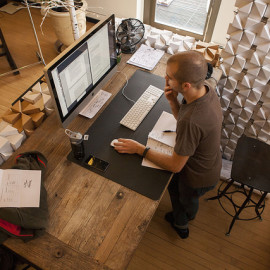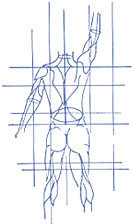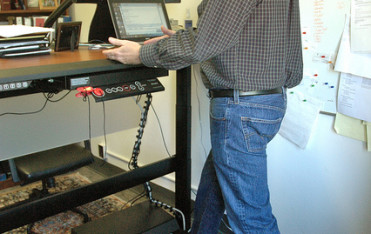There is a lot of back and forth on standing desks. Part of the reason for that though, is that most of the discussions Are fairly one-dimensional. I’d like to discuss briefly the multiple points we need to consider when deciding whether or not to use a standing desk.
1: What is it for?
If your goal is weight loss, this is not going to cut it. While standing does burn more calories than sitting, it won’t be nearly enough to have a real impact on weight. For weight loss, diet is by far most important, followed by physical activity, stress level, and sleep habits. Standing desks should be used to promote musculo-skeletal health.
2: Suddenly standing all day is a bad idea.
Sitting is without a doubt a bad thing for your health. However, if you try to go cold turkey on sitting, you will probably be unsuccessful. Standing for long stretches requires stamina and if you have been sitting most of the time for years, you’ll need to build it up slowly, just as you would a new exercise routine. Get a standing desk that moves up and down so that you can alternate between sitting and standing. Then start slow. Stand for a short time, then sit. Gradually build your standing time over the course of a couple of months. (Go by how it feels)
3: Standing is for muskuloskeletal health.
Many studies and articles about standing desks focus on metrics like mortality rates, weight loss, and activity level. We are not likely to get stellar results if these are the metrics that we hope to change. What standing desks could potentially do a much better job with is helping with the muscular and skeletal systems of the body. Sitting all day contributes to the stiffening of major joints like the hips and shoulders. Alternating between standing and sitting will help to keep those joints and the muscles around them from seizing up in one position.
4: You’re too weak to stand very well, at least right now.
A major factor in the common aches and pains we experience in life is general weakness. That’s part of the reason those band exercises in physical therapy usually help. They add at least a little strength to some very weak areas. Unfortunately, most of the time we do not go far enough with our strength training. These days, almost all professional athletes are doing much more strength training than they used to. At the professional level, even runners are trending towards being able to squat one and a half times their body weight. Most of us – even so called gym rats – struggle to do even a decent body weight squat. (Without getting too far in to it, ‘decent’ is the optimal word here.) Without a baseline of strength, especially on the backside of our bodies, standing for an extended period of time is pretty much guaranteed to hurt. That doesn’t mean we shouldn’t do it, but it does mean that we need to work on rebuilding the strength we’ve lost after years of sitting if we hope to reap the benefits of more standing time.
5: It’s not all or nothing.
There are ways to increase your standing time without extreme changes. For example, if you are someone who does a fair amount of time reading for your work (not emails or anything where you are typing as much as reading) then try doing your reading standing. Get a lectern or a music stand for your office to place any papers or an ipad on, or just hold it in front of your face. Another option is to make all your calls standing. A headset for your telephone can allow you to even pace back and forth in the office. This will give you some added walking time throughout the day, which is a huge bonus for the body. One other biggie is to take a real lunch break. Get up and out of the office instead of eating at your desk.
REFERENCE
5 Ways Your Standing Desk Is Doing More Harm Than Good
Office Ergonomics Training and a Sit-Stand Work Station
Stand More At Work, Sit More At Home
PHOTO – Juhan Sonin, Studio Desks, Eric Benoit, License


